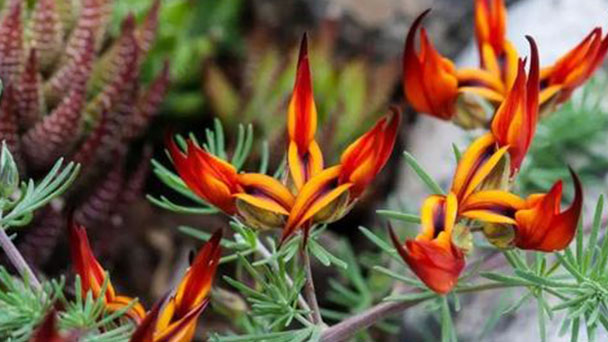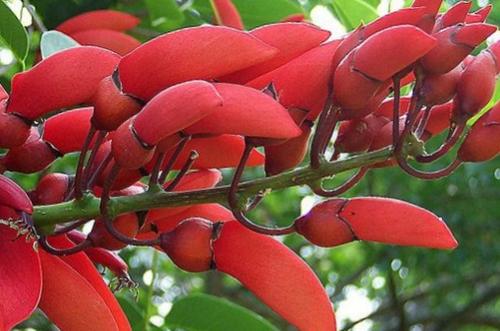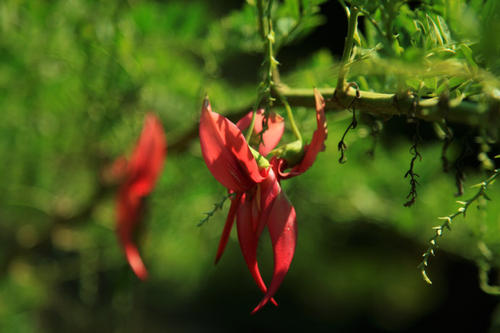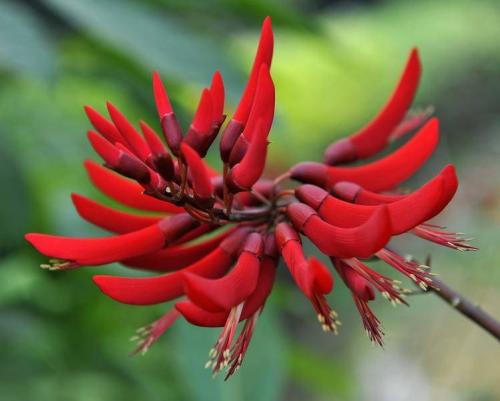Parrots bill (Clianthus puniceus) profile
Written by Maggie
Mar 08 2021

Parrot's Bill, scientific name Clianthus puniceus, also called kaka beak, prefers mild climates and does not tolerate cold or extreme heat, and is usually cultivated in a greenhouse. Parrot's Bill is endangered. Endangered: EN Endangered.
Parrot's Bill picture

The morphological characteristics of parrot's bill
Branch
Parrot's bill is a twining vine, 2 -- 7 m long, much branched; All except corolla sparsely to densely yellow-brown villous. Stem is angulated when young.
Leaf
Parrot's bill has odd pinnate compound leaves 10 -- 25 cm long; Petiole and rachis is slightly angulated, densely brownish hairy; Stipules are linear-lanceolate to awn, 11-15 mm long, sparsely hairy above, persistent; Leaflets have 9-16 pairs, opposite or subopposite, oblong to ovate-oblong, 2-5.5 cm long, 1-1.5 cm wide, apex obtuse to acute, with awns ca. 2 mm long, base rounded to broadly cuneate, entire, both surfaces covered with brown hair, lower midrib more densely on both sides, margin with dense eyelash, lateral veins 7-10 pairs; Petiole ca. is 2 mm; Stipules of Parrot's Bill are persistent, awn-shaped, 3-5 mm long.
Flowers
Parrot's bill has racemes 10 -- 15 cm long; Inflorescence rachis and pedicels densely brown hairy; Bracts are ovate-lanceolate, 1.6-2 cm long, apex caudate-long, bracteoles small, 2-4 mm long; Most;Pedicels are 7 -- 10 mm long; Calyx of Parrot's Bill is 3 -- 4 mm long, densely brownish hairy, calyx teeth 5, upper 2 inconspicuous, lower 3 broadly triangular; Corolla is purplish red to violet, red flag backwards reflex, elliptic, 15 to 17 mm long, about 11 mm wide, apex rounded, base nearly cordate, lobes short shank width, petals oval oblong, ca. 12 mm long, about 5 mm wide, have short concave, apex obtuse, base have drooping ears, keel sickle bending, about 17 mm long, a long wing flap, at its widest point up to 5 mm, apex slightly thickened, curved beak shape; Stamens are disomic, anthers elliptic; Ovary of Parrot's Bill is linear, ca. 10 mm, glabrous, base long stalk, style upcurved, ovules 6-10.
Fruit
Parrot's Bill's pods are linear cylindrical, 7-9 cm long, 8-9 mm in diameter, 7 mm long beak, 5 mm long fruit neck, dark brown exocarp after dry, papery, thin and brittle, white endocarp, cartilaginous, often separated, slightly narrowed between seeds, with 6 -- 10 seeds; Seeds of Parrot's Bill are bright black, elliptic reniform, ca. 6 mm long, 3.5 mm wide, hilum broadly ovate.
Parrot's bill's ecological habits
Parrot's bill prefers mild climates and does not tolerate cold or extreme heat, and is usually grown in a greenhouse.

Parrot's Bill's distribution region
Parrot's Bill is originally from New Zealand.
Parrot's Bill's propagation
Parrot's Bill propagates by sowing or cutting.
Parrot's bill landscaping purposes
Parrot's bill is a greenhouse ornamental.

Latest Updated
- Benefits of Bugleweed - 7 Science-backed Health Benefits
- Bugleweed Dangers & Side Effects - Is It Poisonous?
- How to Plant Evergreen Trees - What You Should Know
- When to Plant Evergreens - Grow Guide for Evergreen Trees
- 12 Wonderful Evergreen Shrubs for Your Garden
- 12 Popular Evergreen Plants with Pictures for Beginners
- When And How To Prune A Lilac Bush Like a Pro
- How to Grow & Care for Lilac Vine (Hardenbergia Violacea)
- Japanese Lilac Tree (Syringa Reticulata) Care & Propagation Guide
- Shumard Oak Pros and Cons - What to Know
Popular Articles
- Winter maintenance of Antirrhinum Majus
- How to Grow Terminalia Mantaly Tree
- How to Grow and Care for Crossostephium Chinense
- How to grow Antirrhinum Majus in spring
- Peristeria Elata (Dove Orchid) Profile: Info & Care Guide
- Underwatered Snake Plant (Sansevieria Trifasciata) - Signs And How To Fix
- How to Care for Brazilian Jasmine Plant (Mandevilla Sanderi)
- How to Grow & Care for Graptopetalum Purple Delight in Summer
- Rosa Chinensis (China Rose): Plant Growing & Care Tips
- How to Care for Baby Sun Rose (Aptenia Cordifolia)